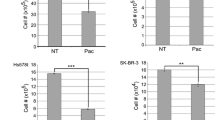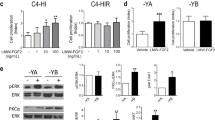Abstract
The c-fms proto-oncogene encoded CSF-1 receptor and its ligand represent a feedback loop, which in a paracrine manner, is well known to promote spread of breast cancers. The role of the autocrine feedback loop in promotion of breast tumor behavior, in particular in vitro, is less well understood. The physiologic stimulation of c-fms expression by glucocorticoids (GCs) in vitro and in vivo magnifies the tumor promoting effect seen in these cells from activated c-fms signaling by CSF-1. Targeted molecular therapy against c-fms could therefore abrogate both complementary feedback loops. Using breast cancer cells endogenously co-expressing receptor and ligand, we used complementary approaches to inhibit c-fms expression and function within this autocrine pathway in the context of GC stimulation. Silencing RNA (shRNA), antisense oligonucleotide therapy (AON), and inhibition of c-fms signaling, were all used to quantitate inhibition of GC-stimulated adhesion, motility, and invasion of human breast cancer cells in vitro. shRNA to c-fms downregulated GC-stimulated c-fms mRNA by fourfold over controls, correlating with over twofold reduction in cellular invasiveness. AON therapy was also able to inhibit GC stimulation of c-fms mRNA, and resulted in threefold less invasiveness and 1.5 to 2-fold reductions in adhesion and motility. Finally, the small-molecule c-fms inhibitor Ki20227 was able to decrease in a dose–response manner, breast cancer cell invasion by up to fourfold. Inhibition of this receptor/ligand pair may have clinical utility in inhibition of the autocrine as well as the known paracrine interactions in breast cancer, thus further supporting use of targeted therapies in this disease.








Similar content being viewed by others
Abbreviations
- Dex:
-
Dexamethasone
- FCS:
-
Fetal calf serum
- ON:
-
Overnight
- AON:
-
Antisense oligonucleotide
- GC:
-
Glucocorticoid
- qRT-PCR:
-
Quantitative real time reverse transcriptase polymerase chain reaction
- siRNA:
-
Silencing RNA
- shRNA:
-
Small hairpin RNA
References
Kacinski BM, Scata KA, Carter D, Yee LD, Sapi E, King BL, Chambers SK, Jones MA, Pirro MH, Stanley ER, Rohrschneider LR (1991) FMS (CSF-1 receptor) and CSF-1 transcripts and protein are expressed by human breast carcinomas in vivo and in vitro. Oncogene 6:941–952
Flick MB, Sapi E, Perrotta PL, Maher MG, Halaban R, Carter D, Kacinski BM (1997) Recognition of activated CSF-1 receptor in breast carcinomas by a tyrosine 723 phosphospecific antibody. Oncogene 14:2553–2561
Scholl SM, Mosseri V, Tang R, Pouillart P (1993) Expression of colony stimulating factor-1 and its receptor (the protein product of c-fms) in invasive breast tumor cells. Ann NY Acad Sci 698:131–135
Kluger HM, Dolled-Filhart M, Rodov S, Kacinski BM, Camp RL, Rimm DL (2004) Macrophage colony-stimulating factor-1 receptor expression is associated with poor outcome in breast cancer by large cohort tissue microarray analysis. Clin Cancer Res 10:173–177
Scholl SM, Pallud C, Beuvon F, Hacene K, Stanley ER, Rohrschneider L, Tang R, Pouillart P, Lidereau R (1994) Anti-colony-stimulating factor-1 antibody staining in primary breast adenocarcinomas correlates with marked inflammatory cell infiltrates and prognosis. J Natl Cancer Inst 86:120–126
Maher MG, Sapi E, Turner B, Gumbs A, Perrotta PL, Carter D, Kacinski BM, Haffty BG (1998) Prognostic significance of colony-stimulating factor receptor expression in ipsilateral breast cancer recurrence. Clin Cancer Res 4:1851–1856
Tang R, Kacinski B, Validire P, Beuvon F, Sastre X, Benoit P, De la Rochefordiere A, Mosseri V, Pouillart P, Scholl S (1990) Oncogene amplification correlates with dense lymphocyte infiltration in human breast cancers: a role for hematopoietic growth factor release by tumor cells? J Cell Biochem 44:189–198
McDermott RS, Deneux L, Mosseri V, Vedrenne J, Clough K, Fourquet A, Rodriguez J, Cosset JM, Sastre X, Beuzeboc, Pouillart P, Scholl SM (2002) Circulating macrophage colony stimulating factor as a marker of tumour progression. Eur Cytokine Netw 13:121–127
Sapi E (2004) The role of CSF-1 in normal physiology of mammary gland and breast cancer: an update. Exp Biol Med 229(1):1–11
Aharinejad S, Paulus P, Sioud M, Hofmann M, Zins K, Schafer R (2004) Colony-stimulating factor-1 blockade by antisense oligonucleotides and small interfering RNAs suppresses growth of human mammary tumor xenografts in mice. Cancer Res 64:5378–5384
Paulus P, Stanley ER, Schafer R, Abraham D, Aharinejad S (2006) Colony-stimulating factor-1 antibody reverses chemoresistance in human MCF-7 breast cancer xenografts. Cancer Res 66:4349–4356
Lin EY, Nguyen AV, Russell RG, Pollard JW (2001) Colony-stimulating factor 1 promotes progression of mammary tumors to malignancy. J Exp Med 193(6):727–740
Pollard JW (2009) Trophic macrophages in development and disease. Nat Rev Immunol 9:259–270
Hernandez L, Smirnova T, Kedrin D, Wyckoff J, Zhu L, Stanley ER, Cox D, Muller WJ, Pollard JW, Van Rooijen N (2009) Segall JE (2009) The EGF/CSF-1 paracrine invasion loop can be triggered by Heregulin ß1 and CXCL12. Cancer Res 69:3221–3227
Goswami S, Sahai E, Wyckoff JB, Cammer M, Cox D, Pixley FJ, Stanley ER, Segall JE, Condeelis JS (2005) Macrophages promote the invasion of breast carcinoma cells via a colony-stimulating factor-1/epidermal growth factor paracrine loop. Cancer Res 65:5278–5283
Wrobel CN, Debnath J, Lin E, Beausoleil S, Roussel MF, Brugge JS (2004) Autocrine CSF-1R activation promotes Src-dependent disruption of mammary epithelial architecture. J Cell Biol 165(2):263–273
Borycki AG, Smadja F, Stanley R, Leibovitch SA (1995) Colony-stimulating factor 1 (CSF-1) is involved in an autocrine growth control of rat myogenic cells. Exp Cell Res 218:213–222
Sapi E, Flick MB, Rodov S, Gilmore-Hebert M, Kelley M, Rockwell S, Kacinski BM (1996) Independent regulation of invasion and anchorage-independent growth by different autophosphorylation sites of the macrophage colony-stimulating factor 1 receptor. Cancer Res 56:5704–5712
Gunawardane RN, Sgroi DS, Wrobel CN, Koh E, Daley GQ, Brugge JS (2005) Novel role for PDEF in epithelial cell migration and invasion. Cancer Res 65:11572–11580
Chambers SK, Wang Y, Gertz RE, Kacinski BM (1995) Macrophage colony-stimulating factor mediates invasion of ovarian cancer cells through urokinase. Cancer Res 55:1578–1585
Filderman AE, Bruckner A, Kacinski BM, Deng N, Remold HG (1992) Macrophage colony-stimulating factor (CSF-1) enhances invasiveness in CSF-1 receptor-positive carcinoma cell lines. Cancer Res 52:3661–3666
Toy EP, Bonafe N, Savlu A, Zeiss C, Zheng W, Flick M, Chambers SK (2005) Correlation of tumor phenotype with c-fms proto-oncogene expression in an in vivo intraperitoneal model for experimental human breast cancer metastasis. Clin Exp Metastasis 22(1):1–9
Das SK, Stanley ER, Guilbert LJ, Forman LW (1981) Human colony-stimulating factor (CSF-1) radioimmunoassay: resolution of three subclasses of human colony-stimulating factors. Blood 58:630–641
Patsialou A, Wyckoff J, Wang Y, Goswami S, Stanley ER, Condeelis JS (2009) Invasion of human breast cancer cells in vivo requires both paracrine and autocrine loops involving the colony-stimulating factor-1 receptor. Cancer Res 69:9498–9506
Sapi E, Flick MB, Gilmore-Hebert M, Rodov S, Kacinski BM (1995) Transcriptional regulation of the c-fms (CSF-1R) proto-oncogene in human breast carcinoma cells by glucocorticoids. Oncogene 10:529–542
Chambers SK, Wang Y, Gilmore-Hebert M, Kacinski BM (1994) Post-transcriptional regulation of c-fms proto-oncogene expression by dexamethasone and of CSF-1 in human breast carcinomas in vitro. Steroids 59:514–522
Kacinski BM, Flick MB, Sapi E (2001) RU-486 can abolish glucocorticoid-induced increases in CSF-1 receptor expression in primary human breast carcinoma specimens. J Soc Gynecol Investig 8:114–116
Wei S, Nandi S, Chitu V, Yeung YG, Yu W, Huang M, Williams LT, Lin H, Stanley ER (2010) Functional overlap but differential expression of CSF-1 and IL-34 in their CSF-1 receptor-mediated regulation of myeloid cells. J Leukoc Biol 88:495–505
Wiktor-Jedrzejczak W, Bartocci A, Ferrante AW Jr, Ahmed-Ansari A, Sell KW, Pollard JW, Stanley ER (1990) Total absence of colony-stimulating factor 1 in the macrophage-deficient osteopetrotic (op/op) mouse. Proc Natl Acad Sci USA 87:4828–4832
Toy EP, Azodi M, Folk NL, Zito CM, Zeiss CJ, Chambers SK (2009) Enhanced ovarian cancer tumorigenesis and metastasis by the macrophage colony-stimulating factor (CSF-1). Neoplasia 11(2):136–144
Ohno H, Kubo K, Murooka H, Kobayashi Y, Nishitoba T, Shibuya M, Yoneda T, Isoe T (2006) A c-fms tyrosine kinase inhibitor, Ki20227, suppresses osteoclast differentiation and osteolytic bone destruction in a bone metastasis model. Mol Cancer Ther 5(11):2634–2643
Hiraga T, Nakamura H (2009) Imatinib mesylate suppresses bone metastases of breast cancer by inhibiting osteoclasts through the blockade of c-Fms signals. Int J Cancer 124:215–222
Chambers SK (2000) In vitro invasion assays. In: Bartlett J (ed) Methods in molecular medicine: ovarian cancer. Humana Press Inc., Totowa, NJ, pp 179–185
Chambers SK, Ivins CM, Kacinski BM, Hochberg RB (2004) An unexpected effect of glucocorticoids on stimulation of c-fms proto-oncogene expression in choriocarcinoma cells expressing little glucocorticoid receptor. Am J Obstet Gynecol 190:974–985
Chambers SK, Gilmore-Hebert M, Wang Y, Rodov S, Benz EJ, Kacinski BM (1993) Post-transcriptional regulation of CSF-1 and CSF-1 receptor gene expression during inhibition of phorbol-ester induced monocytic differentiation by dexamethasone and cyclosporin A: potential involvement of a destabilizing protein. Exp Hematol 21:1328–1334
Woo HH, Zhou Y, Yi X, David CL, Zheng W, Gilmore-Hebert M, Kluger HM, Ulukus EC, Baker T, Stoffer JB, Chambers SK (2009) Regulation of non AU-rich element containing c-fms proto-oncogene expression by HuR in breast cancer. Oncogene 28(9):1176–1186
Woo HH, Yi X, Lamb T, Menzl I, Baker T, Shapiro DJ, Chambers SK (2010) Post-transcriptional suppression of proto-oncogene c-fms expression by vigilin in breast cancer. Mol Cell Biol. doi:10.1128/MCB.01031-10
Lorinz P, Misteli T, Baker BF, Bennett CF, Spector DL (2000) Nucleocytoplasmic shuttling: a novel in vivo property of antisense phosphorothioate oligodeoxynucleotides. Nucleic Acids Res 28(2):582
Yang W, Saad M, Pakunlu RI, Khandare JJ, Garbuzenko OB, Vetcher AA, Soldatenkov VA, Pozharov VP, Minko T (2008) Nonviral nanoscale-based delivery of antisense oligonucleotides targeted to hypoxia-inducible factor 1α enhances the efficacy of chemotherapy in drug-resistant tumor. Clin Cancer Res 14(11):3607–3616
Acknowledgments
This study is supported by DOD Grant DAMD 17-02-1-0633 (to SKC), Arizona Biomedical Research Commission Grant #0802 (to SKC), and Rodel Foundation (to SKC).
Author information
Authors and Affiliations
Corresponding author
Rights and permissions
About this article
Cite this article
Toy, E.P., Lamb, T., Azodi, M. et al. Inhibition of the c-fms proto-oncogene autocrine loop and tumor phenotype in glucocorticoid stimulated human breast carcinoma cells. Breast Cancer Res Treat 129, 411–419 (2011). https://doi.org/10.1007/s10549-010-1247-7
Received:
Accepted:
Published:
Issue Date:
DOI: https://doi.org/10.1007/s10549-010-1247-7




